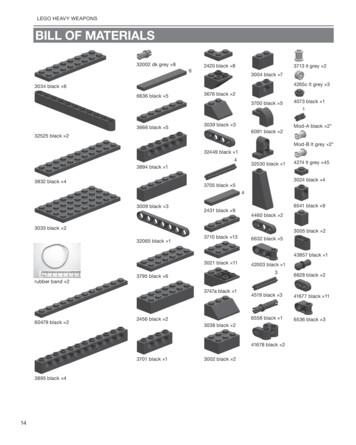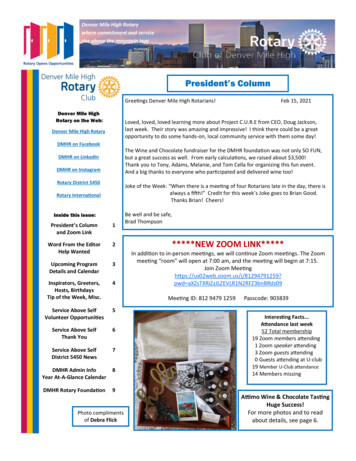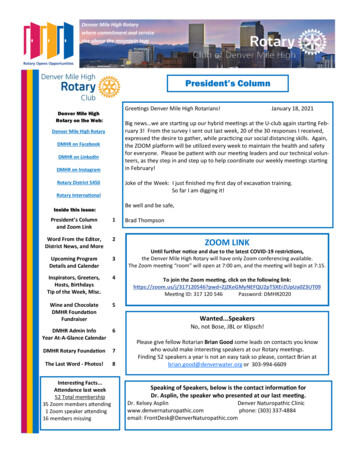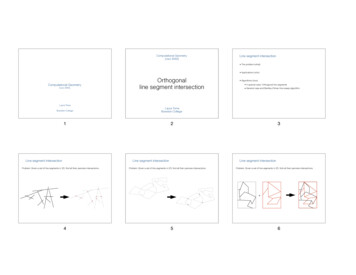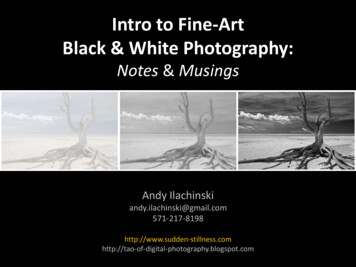
Transcription
Intro to Fine-ArtBlack & White Photography:Notes & MusingsAndy photography.blogspot.com
Outline of ClassFour Dimensions of Photography Practical DimensionCameras, lenses, filters, bags, With abit of Ourmain focusin thisworkshopWith abit of Technical DimensionMetering, f-stops, focus, Artistic DimensionAesthetics, composition, design, Philosophical DimensionWhat does your photography mean? to you? to others?
Outline of ClassMusings: Five Take-Away Points Photography:The art of capturing what a “thing” is Fine-art photography:The art of capturing what else a thing is Color photography:Any type of photography in whichcolor is the main focus of attentionor in which color is the primaryvisual tool that is selectively usedto focus the viewers attention B/W photography:Any type of photography in whichform, tone, texture, and patternare the main focus of attention Content / presentation: All forms of photography depend onthe same basic set of compositional /aesthetic principles
Don’t Miss the Forest for the TreesForestPoint-and-shoot photography isall about grabbing the shot (of something)Oh, what a lovely tree where‟s my camera?.click .let‟s goFine-art photography is all aboutdoing everything possible (before / during / after a shot)to communicate feelings to someone elseI‟m so happy here what beautiful light how calm everything is it‟s as though nothing else exists a gentle breeze serenity
Don’t Miss the Forest for the TreesForestPoint-and-shoot photography isall about grabbing the shot (of something)Oh, what a lovely tree where‟s my camera?.click .let‟s goFine-art photography is all aboutdoing everything possible (before / during / after a shot)to communicate feelings to someone elseI‟m so happy here what beautiful light how calm everything is it‟s as though nothing else exists a gentle breeze serenity Now, on to the TreesThis workshop is offered as a first step towardsdeveloping the skills – and frame of mind / eye / I – tobecome a fine-art photographer
Don’t Miss the Forest for the TreesA point-and-shoot photograph of HawaiiGalen Rowell’s light ntent/uploads/2007/11/oahu-north-beach.jpg
Don’t Miss the Forest for the TreesA point-and-shootA fine-art photographphotographof Hawaiiof HawaiiGalen Rowell’s light g is not enough; you have to feel what you photograph. “— ANDRE KERTESZ, Photographer (1894 - 1985)
Outline of ClassTopics Who is this guy, and why should I listen to him?― And why you ought not listen to him Photography in six easy steps ;-) Fine-art photography― A closer look Color black & white :: Part 1 - examples― Some images are best in color; some beg for B&W Seeing images― Basic elements of design (form, tone, texture, pattern light) Camera vs. eye :: similarities & differences― What photographers need to keep in mind Color black & white :: Part 2 - doing it for yourself― Conversion techniques / programs / plug-ins Moving on to the next level Concluding thoughts :: references Extra :: portfolio samples / East vs. West in art / “complexity”
Outline of ClassTopics Who is this guy, and why should I listen to him?― And why you ought not listen to him Photography in six easy steps ;-) Fine-art photography― A closer look Color black & white :: Part 1 - examples― Some images are best in color; some beg for B&W Seeing images― Basic elements of design (form, tone, texture, pattern light) Camera vs. eye :: similarities & differences― What photographers need to keep in mind Color black & white :: Part 2 - doing it for yourself― Conversion techniques / programs / plug-ins Moving on to the next level Concluding thoughts :: references Extra :: portfolio samples / East vs. West in art / “complexity”
Who am I? and why you ought and ought not listen to me ;-) Whatever I may knowabout light, tone,texture, form, andcompositionI learned bywatching my dad.He was not aphotographer,but was an artistpar excellence The trick is to find it ! — Joseph CampbellFirst camera: 1970Polaroid instamatic / Christmas giftFirst picture: (abstract?) closeup of my right toeFirst “serious” camera: 1982Canon AE-1Ph.D. Theoretical Physics, 1988Complex Adaptive SystemsFirst “serious” digital camera: 1998Nikon Coolpix 950First DSLR: 2001Olympus E-10Everyone’s visionis their own "If the path before you is clear, you'reprobably on someone else's.“Born 1960 / Long Island, NYFirst Solo Show: 2007Coral Gables, FloridaFirst Lenswork portfolio: 2007DVD Edition #71 / July-August First art co-op: 2008One of 14 founding members at Lorton Arts, VA
Recent Activity “Worlds Within Worlds” Exhibit (2009-2010)American Physics Center Solo Exhibit (32 Photographs, 2007)Books & Books / Gallery, Coral Gables, FL 1st Prize, Juried photo exhibit (2009)RoHo Photo Gallery, Cincinnati, OH Honorable MentionPhoto Techniques, Portfolio Contest, 2007 Photography Workhouse Society, 2008/09Lorton Arts, VA "Spirit & Light" portfolioLenswork magazine, Extended EditionIssue #71 (July-August, 2007) Featured photographer (Lenswork Magazine)LOOK3 Photo Festival, Charlotttesville, VA, 2009 Wall calendar and datebookChange Your Mind, Change Your Lifeby Wayne Dyer (Amber Lotus Publishing, 2010) Winner of book contest, 2007U.K. B&W magazine and Envisage Books “Entropic Melodies Series” portfolioFocus Magazine, April 2006 Featured Artist / After WordsNorthern Virginia magazine, August 2009 Merit of Excellence (Abstracts)2007 B&W Spider Awards "Micro Worlds" portfolioLenswork magazine, Print & Extended EditionIssue #76 (May-June, 2008) Portfolio contest winnerBlack & White magazine, Feb 2006 Merit award, single-image contestBlack & White magazine (2008) Semi-finalist, Photographer's Forum magazineAnnual Contest , 2008 Honorable mentionPhoto Techniques, portfolio contest, 2008 Merit award, Abstract ExposureOct 2006 juried on-line exhibit Finalist, Photographer's Forum magazineAnnual Contest , 2005 Third Place, photo contestSybex Publishing gallery contest, 2005
Outline of ClassTopics Who is this guy, and why should I listen to him?― And why you ought not listen to him Photography in six easy steps ;-) Fine-art photography― A closer look Color black & white :: Part 1 - examples― Some images are best in color; some beg for B&W Seeing images― Basic elements of design (form, tone, texture, pattern light) Camera vs. eye :: similarities & differences― What photographers need to keep in mind Color black & white :: Part 2 - doing it for yourself― Conversion techniques / programs / plug-ins Moving on to the next level Concluding thoughts :: references Extra :: portfolio samples / East vs. West in art / “complexity”
Step 1Photography a language“ the concept underlying this phraseis a very important one Just as in the media of the written wordwe have poems, essays, scientific andjournalistic reports, novels,dramas and catalogues,so with photography we touch the domainsof science, illustration, documentationand expressive art.”— ANSEL ADAMSPhotographer (1902 - 1984)
Step 2Photography Communication“Understand what you want to say!Understand how you want to say it!Then say it without compromise!Now you are thinking in terms ofcreative photography!”— BRUCE BARNBAUMThe Art of Photography (2010)
Step 3Photography Feelings“The key is to not let the camera,which depicts nature in so much detail,reveal just what the eye picks up,but what the heart picks up as well.”— PAUL CAPONIGROPhotographer (1932 - )
Step 4Photography ConstantPicturetaking!“To be a photographer,one must photograph.No amount of book learning,no checklist of seminars attended,can substitute for thesimple act of making pictures.Experience is thebest teacher of all.And for that,there are no guarantees thatone will become an artist.Only the journey matters.”— HARRY CALLAHANPhotographer (1912 - 1999)
Step 5Photography is all about “ how you build a picture,what a picture consists of,how shapes are related to each other,how spaces are filled,how the whole thingmust have a kind of unity.”— PAUL STRANDPhotographer (1890 - 1976)
Step 6Photography a personal journey“A man's work is nothing butthis slow trek to discover,through the detours of art,these two or threegreat and simple imagesin whose presence hisheart first opened.”— ALBERT CAMUS
One last step(seldom taught)Concerning the artof fine-art photography“One should not onlyphotograph thingsfor what they are,but for what else they are.”— MINOR WHITEPhotographer (1908 - 1976)Ordinary ink in water transformed into extraordinary organic forms
One last step(seldom taught)Concerning the artof fine-art photographyOrdinarydollopsink in water dollupsofpaint paint Ordinaryof“One should not onlyphotograph thingsfor what they are,but for what else they are.”— MINOR WHITEPhotographer (1908 - 1976) transformed into extraordinary organic forms transformed into mysterious glyphs of a lost language
One last step(seldom taught)Concerning the artof fine-art photography“One should not onlyphotograph thingsfor what they are,but for what else they are.”— MINOR WHITEPhotographer (1908 - 1976)OrdinaryAnordinaryinkcandledollupscandlein water ofholder holder paint transformed transformedinto mysteriousinto extraordinaryglyphs of aorganiclost languageformsAnordinary transformed into otherwordly realms
Outline of ClassTopics Who is this guy, and why should I listen to him?― And why you ought not listen to him Photography in six easy steps ;-) Fine-art photography― A closer look Color black & white :: Part 1 - examples― Some images are best in color; some beg for B&W Seeing images― Basic elements of design (form, tone, texture, pattern light) Camera vs. eye :: similarities & differences― What photographers need to keep in mind Color black & white :: Part 2 - doing it for yourself― Conversion techniques / programs / plug-ins Moving on to the next level Concluding thoughts :: references Extra :: portfolio samples / East vs. West in art / “complexity”
Ansel Adams: A Lesson from the MasterAnsel Adams, Moonrise Over Hernandez, New Mexico, 1941http://www.alindergallery.com/moonrise.jpg
Ansel Adams: A Lesson from the MasterContact PrintAuto CurvesWhat Ansel’s camera saw!What Photoshop does without thephotographer’s intervention (or vision)Ansel Adams, Moonrise Over Hernandez, New Mexico, 1941http://www.alindergallery.com/moonrise.jpg
Ansel Adams: A Lesson from the MasterContact PrintAuto CurvesWhat Ansel’s camera saw!What Photoshop does without thephotographer’s intervention (or vision)Ansel Adams, Moonrise Over Hernandez, New Mexico, 1941―Point-&-shoot photographybegins and ends with the e-art photography starts even before it!
Ansel Adams: (Pre-) VisualizationAs I replaced the slide, I began to think abouthow the print was to appear, and if it wouldtransmit any of the feeling of the monumentalshape before me in terms of its expressiveemotional quality. I began to see in my mind’seye the finished print I desired: the brooding cliffwith a dark sky and the sharp rendition ofdistant, snowy Tenaya Peak. I realized that onlya deep red filter would give me anythingapproaching the effect I felt emotionally. I hadonly one plate left. I attached my other filter, aWratten #29(F), increased the exposure by thesixteen-times factor required, and released theshutter. I felt I had accomplished something, butdid not realize its significance until I developedthe plate that evening.I had achieved my first true visualization!I had been able to realize a desired image: notthe way the subject appeared in reality but howit felt to me and how it must appear in thefinished print.— Ansel Adams, Autobiography, p. 76
Capturing an image Crafting an image"The negative is comparable to the composer's score and the print to its performance.Each performance differs in subtle ways. “ - Ansel Adams
Capturing an image Crafting an image"The negative is comparable to the composer's score and the print to its performance.Each performance differs in subtle ways. “ - Ansel Adams“Performance” #1“Performance” #2“Score” Original raw capture / default settings“Performance” #3
Dimensions of a photographDimensionsof ―Reality‖Dimensionsof aceTimeWeatherDimensions―evoked‖ olicSynestheticWhat can a Photographer do?Find subject matterWait for ―best‖ light /conditionsChoose vantage pointFrame / croppingPlane of focusExposure timePostprocessing(Photoshop, )This is essentiallyall the photographerhas to work with toconstruct an image!Tonal manipulation,skillfully & artfully applied,focuses photographer’sintended message
Capture Process, not Disconnected ThingsDecisive MomentDecisive Moment “The simultaneous recognition, in a fraction of a second,of the significance of an event as well as the precise organization of forms which givesthat event its proper expression.”“Above all, I craved to seize the whole essence, in the confines of one single photograph,of some situation that was in the process of unrolling itself before my eyes.”— Henri Cartier Bresson (1908 - 2004)
Capture Process, not Disconnected ThingsDecisive MomentDecisive Moment “The simultaneous recognition, in a fraction of a second,of the significance of an event as well as the precise organization of forms which givesthat event its proper expression.”“Above all, I craved to seize the whole essence, in the confines of one single photograph,of some situation that was in the process of unrolling itself before my eyes.”— Henri Cartier Bresson (1908 - 2004)This is not a picture ofmy son, his hand, or theripples in the water It is a picture of whatmy son is doing !
Outline of ClassTopics Who is this guy, and why should I listen to him?― And why you ought not listen to him Photography in six easy steps ;-) Fine-art photography― A closer look Color black & white :: Part 1 - examples― Some images are best in color; some beg for B&W Seeing images― Basic elements of design (form, tone, texture, pattern light) Camera vs. eye :: similarities & differences― What photographers need to keep in mind Color black & white :: Part 2 - doing it for yourself― Conversion techniques / programs / plug-ins Moving on to the next level Concluding thoughts :: references Extra :: portfolio samples / East vs. West in art / “complexity”
Black & White vs. ColorMajor distinction Color depicts reality
Black & White vs. ColorMajor distinction Color depicts realityBlack & White(allows thephotographer to)interpret reality
Black & White vs. Color B&W images are – by their nature – abstract and can toleratemuch more tonal manipulation without sacrificing realism Require a different – deliberate - style of “seeing” Ansel Adams was a great B&W “seer” and photographer;But he was (arguably) only a “so-so” color “seer” Tip: if you are using a DSLR, set picture style to B&Wto use LCD for previewing compositions in B&WAllows selective focus of viewer’s attention Toning / burning / dodging / Not all subjects are suitable for B&W; those that are,tend to have these properties in common: Color is not the primary (or even secondary) focusThe graphic content of the image is strong without colorColor is a distraction to the overall “mood” of the pictureThe scene includes interesting contrast between light and darkShadows play an important role in the compositionYou want to deliberately inject an “old fashioned” feel into the image
Black & White vs. ColorSome images simply must remain in color!
Black & White vs. ColorSome images simply must remain in color!
Black & White vs. ColorSome images work well in color & B&WBut inducevery differentmoods!
Black & White vs. ColorSome images work well in color & B&W
Black & White vs. ColorSome images work well in color & B&W
Black & White vs. ColorSome images beg for B&W (color adds essentially nothing)!
Black & White vs. ColorSome images beg for B&W (color adds essentially nothing)!
Black & White vs. ColorSome ideas / tips for finding B&W imagesTwo useful filters:PolarizerNeutral density Shoot in RAW AbstractsArchitectureClose-ups (of everyday things)ContrastsFigure study / modelsHigh / low keyLight / dark spacesPatternsPortraitsSelective coloringSimplicity (less is more)Street photographySubtle lightingShape & formTexturesWater / flow (long exposures)
Outline of ClassTopics Who is this guy, and why should I listen to him?― And why you ought not listen to him Photography in six easy steps ;-) Fine-art photography― A closer look Color black & white :: Part 1 - examples― Some images are best in color; some beg for B&W Seeing images― Basic elements of design (form, tone, texture, pattern light) Camera vs. eye :: similarities & differences― What photographers need to keep in mind Color black & white :: Part 2 - doing it for yourself― Conversion techniques / programs / plug-ins Moving on to the next level Concluding thoughts :: references Extra :: portfolio samples / East vs. West in art / “complexity”
Seeing Images“Good composition is the artist’s wayof directing the viewer’s vision in a planned,de-randomized fashion.”- Bruce Barnbaum
Composing / DesigningBasic Elements of Design Form Tone Texture Pattern
Form: Single PointA single point creates two primitive relationships within frame:– Implied forces that are proportional to the distance from edges / corners– Implied lines that divide frame into horizontal & vertical boxesCenter Static (Usually) not very interesting (When used selectively) providesstrong, anchored focusSlightly off-center Adds a dynamic element Aesthetics / “feel” depends criticallyon relative positioning to edgesClose to edge (Obviously) “unusual”;Needs strong aesthetic justification Best used as “accent” (for aestheticelements remaining in smaller “box”)
Form: Single Point - ExampleSkye, Scotland (2009) Position and context determines overallmood of the image Centering anchors shot Dark silhouette of subject adds contrast Dark clouds (at top) and dark band of kelpon bottom both anchor and add contrast Subject’s (relative) “smallness” intensifiestotal immersion (into the “infinite”) Snatches of land (left / right) adds stability Water in foreground echoes ocean Layers of rocks and kelp in foregroundecho layers of cloud Vertical space echoes subject’s gaze
Form: Single Point - ExampleAlternative Crops
Form: Multiple Points
Form: Lines Arguably, the most important element– Without lines there is no shape;Without shape there is no form;Without form there is no texture or pattern Lines can lead you away or toward a focusof interest and establish the overall mood Different types induce different emotions:–Vertical power, strength, growth– (Single) horizontal rest, stability High horizon: heaviness, nearness, earthiness Centered horizon: peaceful, quiet, static Low horizon: ethereal, expansive, light––––(Multiple) horizontal drama , rhythmDiagonal action, draw viewer‟s attentionThin unstable, vulnerableThick dominating, rigid, stern– Curved relaxing, soft, soothing– Jagged chaotic, sharp, threatening
Form: Lines Arguably, the most important element– Without lines there is no shape;Without shape there is no form;Without form there is no texture or pattern Lines can lead you away or toward a focusof interest and establish the overall mood Different types induce different emotions:–Vertical power, strength, growth– (Single) horizontal rest, stability High horizon: heaviness, nearness, earthiness Centered horizon: peaceful, quiet, static Low horizon: ethereal, expansive, light––––(Multiple) horizontal drama , rhythmDiagonal action, draw viewer‟s attentionThin unstable, vulnerableThick dominating, rigid, stern– Curved relaxing, soft, soothing– Jagged chaotic, sharp, threateningSometimes the lines are obvious
Form: Lines Arguably, the most important element– Without lines there is no shape;Without shape there is no form;Without form there is no texture or pattern Lines can lead you away or toward a focusof interest and establish the overall mood Different types induce different emotions:–Vertical power, strength, growth– (Single) horizontal rest, stability High horizon: heaviness, nearness, earthiness Centered horizon: peaceful, quiet, static Low horizon: ethereal, expansive, light––––(Multiple) horizontal drama , rhythmDiagonal action, draw viewer‟s attentionThin unstable, vulnerableThick dominating, rigid, stern– Curved relaxing, soft, soothing– Jagged chaotic, sharp, mplicitSometimes
Form: Lines Arguably, the most important element– Without lines there is no shape;Without shape there is no form;Without form there is no texture or patternDarker Lines can lead you away or toward a focusof interest and establish the overall mood Different types induce different emotions:–Vertical power, strength, growth– (Single) horizontal rest, stability High horizon: heaviness, nearness, earthiness Centered horizon: peaceful, quiet, static Low horizon: ethereal, expansive, lightLighter––––(Multiple) horizontal drama , rhythmDiagonal action, draw viewer‟s attentionThin unstable, vulnerableThick dominating, rigid, stern– Curved relaxing, soft, soothing– Jagged chaotic, sharp, mplicitSometimes
Form: Multiple Lines
Form: Multiple Lines
Form: Multiple Lines
Form: Multiple Lines
Form: Shapes - Triangles The most dynamic of thebasic compositional elements (at least one of) its sidescreates a diagonal line,suggesting a visual flow Triangular shape is foreignto the rectangular frame invites viewer’s attention
Form: Shapes - Triangles
Form: Shapes - Triangles
Form: Shapes – Squares / Rectangles
Form: Shapes – Squares / Rectangles
Form: Shapes – Squares / Rectangles
Form: Shapes – Circles / Ovals
Form: Shapes – Circles / Ovals
Form: Shapes – Circles / Ovals Circular objects typically portraycalm, serenity; invite contemplation Tend to grab hold of aviewer’s attention Because circles / ovals are sodifferent from a rectangular frame,they are usually dominant areas
Form: Shapes – Combined
Form: Shapes – Combined
Form: Shapes – Combined
Form: Shapes – CombinedEven seemingly very complex combinations“Complex” onlyin the detailsReally Simple shapes texture / pattern
Basic Elements of DesignTone Arguably the most intangible elementMay consist of shadings from white gray blackMarks consist of darks again lights with little grayUseful in adding a 3rd dimension to a ―flat‖ B&W imageHelps create a ―mood‖ of a composition ―High key‖ images convey lightness, joy ―Low key‖ images convey darkness, mystery– Tonal contrasts create boundaries between objectsthat aid in building aesthetic compositions–––– Developing an intuition for the tonal distributionof an image –– both before and after a photo hasbeen taken –– is critical There is no such thing as an ideal histogram;histograms merely define the tonal range in ascene and are to be used to assist thephotographer in conveying the desired mood
Basic Tonal ElementsBrightness & ContrastPredominantly light(―High key‖)Low contrastGlobal ContrastdarkerBalanced RangelighterPredominantly dark(―Low key‖)
Basic Tonal ElementsLocal vs. Global ContrastBoost global contrastBoost global contrast more by using curvesEnhance local contrast either by selectingpart of image (and using curves again),or applying Unsharp Mask
Basic Tonal ElementsLocal vs. Global ContrastInitial B&W conversionGlobal contrast boostLocal contrast boost
Basic Elements of DesignBe mindful of other possible contrastsLight / darkNear / farLarge / smallSharp / diffuseOne / all
Basic Elements of DesignBe mindful of other possible contrastsThin / ThickBroad / narrowOne / manyPlane / volumeSolid / liquidLinear / circular
Basic Elements of DesignBe mindful of other possible contrastsSharp / softBlack / whiteSolid / liquidFlow / motionlessSmooth / rough
Basic Elements of DesignTexture Refers to the roughness or smoothness of a surface– Often over-looked as a visual design element– Appearance depends on how close to (or far away from)you are from them– Made more visible by using side-lighting creates shadows on surface in proportion to roughness– Contrasts between textures creates boundaries betweenobjects (much as tonal contrasts do)– Textures may be used as the sole focus of a composition,but we aware of possible (unintended) distractions You can create textures(in otherwise textureless environments)– Using a long exposure, pan the camerahorizontally across a scene– Combine – slightly staggered - multiple exposuresof the same scene
Basic Elements of DesignTexture Refers to the roughness or smoothness of a surface– Often over-looked as a visual design element– Appearance depends on how close to (or far away from)you are from them– Made more visible by using side-lighting creates shadows on surface in proportion to roughness– Contrasts between textures creates boundaries betweenobjects (much as tonal contrasts do)– Textures may be used as the sole focus of a composition,but we aware of possible (unintended) distractions You can create textures(in otherwise textureless environments)– Using a long exposure, pan the camerahorizontally across a scene– Combine – slightly staggered - multiple exposuresof the same scene
Basic Elements of DesignTexture Refers to the roughness or smoothness of a surface– Often over-looked as a visual design element– Appearance depends on how close to (or far away from)you are from them– Made more visible by using side-lighting creates shadows on surface in proportion to roughness– Contrasts between textures creates boundaries betweenobjects (much as tonal contrasts do)– Textures may be used as the sole focus of a composition,but we aware of possible (unintended) distractions You can create textures(in otherwise textureless environments)– Using a long exposure, pan the camerahorizontally across a scene– Combine – slightly staggered - multiple exposuresof the same scene
Basic Elements of DesignPattern Fundamental component of nature;not just photography(I’m speaking here as a physicist ;-)– Often over-looked as a visual design element– Does not have to be perfect to be useful
Basic Elements of DesignPattern Fundamental component of nature;not just photography(I’m speaking here as a physicist ;-)– Often over-looked as a visual design element– Does not have to be perfect to be useful Two ways to use it compositionally– Emphasize the pattern
Basic Elements of DesignPattern Fundamental component of nature;not just photography(I’m speaking here as a physicist ;-)– Often over-looked as a visual design element– Does not have to be perfect to be useful Two ways to use it compositionally– Emphasize the pattern– Deliberately break the pattern Ex: add a contrasting object (shape,texture) or remove a repeating object(s) Note: the element that breaks the patternbecomes a new ―point‖ in composition(figure ground)
Basic Elements of DesignPattern Fundamental component of nature;not just photography(I’m speaking here as a physicist ;-)– Often over-looked as a visual design element– Does not have to be perfect to be useful Two ways to use it compositionally– Emphasize the pattern– Deliberately break the pattern Ex: add a contrasting object (shape,texture) or remove a repeating object(s) Note: the element that breaks the patternbecomes a new ―point‖ in composition(figure ground)
Basic Elements of DesignPattern Fundamental component of nature;not just photography(I’m speaking here as a physicist ;-)– Often over-looked as a visual design element– Does not have to be perfect to be useful Two ways to use it compositionally– Emphasize the pattern– Deliberately break the pattern Ex: add a contrasting object (shape,texture) or remove a repeating object(s) Note: the element that breaks the patternbecomes a new ―point‖ in composition(figure ground)
Basic Elements of DesignPattern Fundamental component of nature;not just photography(I’m speaking here as a physicist ;-)– Often over-looked as a visual design element– Does not have to be perfect to be useful Two ways to use it compositionally– Emphasize the pattern– Deliberately break the pattern Ex: add a contrasting object (shape,texture) or remove a repeating object(s) Note: the element that breaks the patternbecomes a new ―point‖ in composition(figure ground)
Basic Elements of DesignBalance / Distribution of Visual Weight Balance resolution of tension;of opposing forces (contrasts) The eye seeks to balance visible forces Balance aesthetic harmony Unless disharmony is the objective !
Basic Elements of DesignBalance / Distribution of Visual Weight Balance resolution of tension;of opposing forces (contrasts) The eye seeks to balance visible forces Balance aesthetic harmony Unless disharmony is the objective ! Symmetry works only when it is perfect
Basic Elements of DesignBalance / Distribution of Visual Weight Balance resolution of tension;of opposing forces (contrasts) The eye seeks to
creative photography!” —BRUCE BARNBAUM The Art of Photography (2010) Step 2. Photography Feelings “The key is to not let the camera, which depicts nature in so much detail, reveal just what th
